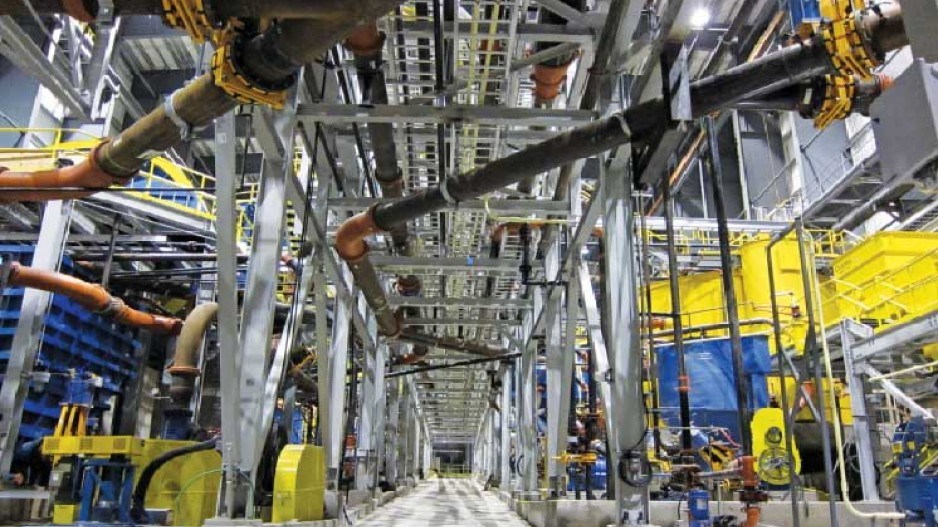On February 27, the first truckload of copper concentrate left the Red Chris mine site, 59 years after the rich copper porphyry deposit was discovered 80 kilometres south of Dease Lake.
It’s the second greenfield mine (the first being Mount Milligan) to open in B.C. since the BC Liberal government, elected in 2001, set out to reinvigorate B.C.’s mining industry.
More importantly, it was one of the catalysts for the $746 million, 344-kilometre Northwest Transmission Line (NTL), which was built to power up new mines in the Golden Triangle region of northwest B.C. along the Alaska Panhandle.
It’s also something of a case study for how long it can take to bring a new mine from discovery to production and how many hurdles it has to jump in the process.
For Imperial Metals (TSX:III), the company that built the $500 million mine, one of those hurdles was last year’s failure of its Mount Polley mine’s tailings pond, which pushed back Red Chris’ production timeline and cast a pall over what was otherwise a good-news story for the B.C. mining industry.
“Obviously the world has changed since Mount Polley, and in particular with this company owning the Mount Polley mine, we’ve had to take some extra time,” said B.C. Energy and Mines Minister Bill Bennett. “It doesn’t take away from the important opportunity that this mine is for B.C. mining.”
The mine employs 310 workers, 35% of whom are First Nations.
“The vast majority of them are Tahltan,” said Steve Robertson, Imperial Metals’ vice-president of corporate affairs.
Some come from the village of Iskut, which used to get its power from diesel generators and now gets its power from the grid, thanks to the NTL.
The deposit that would eventually become Red Chris mine was first explored in 1956 by Conwest Exploration Co. Over the years, junior exploration companies kept coming back to it, staking several claims, but its remote location near the Alaska Panhandle and lack of power were always major impediments.
It wasn’t until the B.C. government started considering bringing electricity to the region that Red Chris and other mines in the region became economically viable to develop.
In 2003, bcMetals Corp. acquired the property, and two years later it received an environmental assessment certificate. Imperial Metals acquired the property in a hostile takeover of bcMetals in 2007.
It took six years and a major court battle that went to the Supreme Court of Canada before the mine was issued a Mines Act permit in 2013.
The legal battle centred on the fact that federal regulators allowed an environmental assessment to proceed as a screening rather than as a comprehensive study.
The mine was allowed to proceed, but the Supreme Court ruling would have implications for future mines going through the environmental approval process, because the court ruled that future projects needing a comprehensive study could not be broken into smaller parts for environmental screenings.
With estimated reserves of 2.08 billion pounds of copper and 1.32 million ounces of gold, Red Chris is expected to have an annual average production of 30,000 tonnes of ore over three decades once it’s in full production this summer.
But that production plan is based on a 2004 feasibility study, and further exploration has revealed the deposit to be much richer than originally thought.
Initial drilling went to depths of about 400 metres.
Additional exploration between 2007 and 2012 involved drilling to depths of up to 1.5 kilometres to reveal rich veins of copper and gold.
“What’s different about Red Chris is that the previous work that was done was all in the low-grade outer rind of the deposit, whereas what we discovered was the true core of the deposit,” Robertson said.
The current mine plan is based largely on copper production, but Robertson said the mine has the potential to become a significant gold producer.
Before that can happen, an optimization plan will need to be created. Further phases of mining could include going underground.
Now that the NTL has paved the way, three other new mines in the region are making their way through the various approval stages:
•the $750 million gold-silver underground Brucejack gold mine proposed by Pretium Resources Inc. (TSX:PVG);
•Alloycorp Mining Inc.’s (TSX-V:AVT) $800 million restart of the Kitsault molybdenum mine; and
•Seabridge Gold Inc.’s (TSX:SEA) proposed $5.3 billion KSM copper-gold-molybdenum mine.




